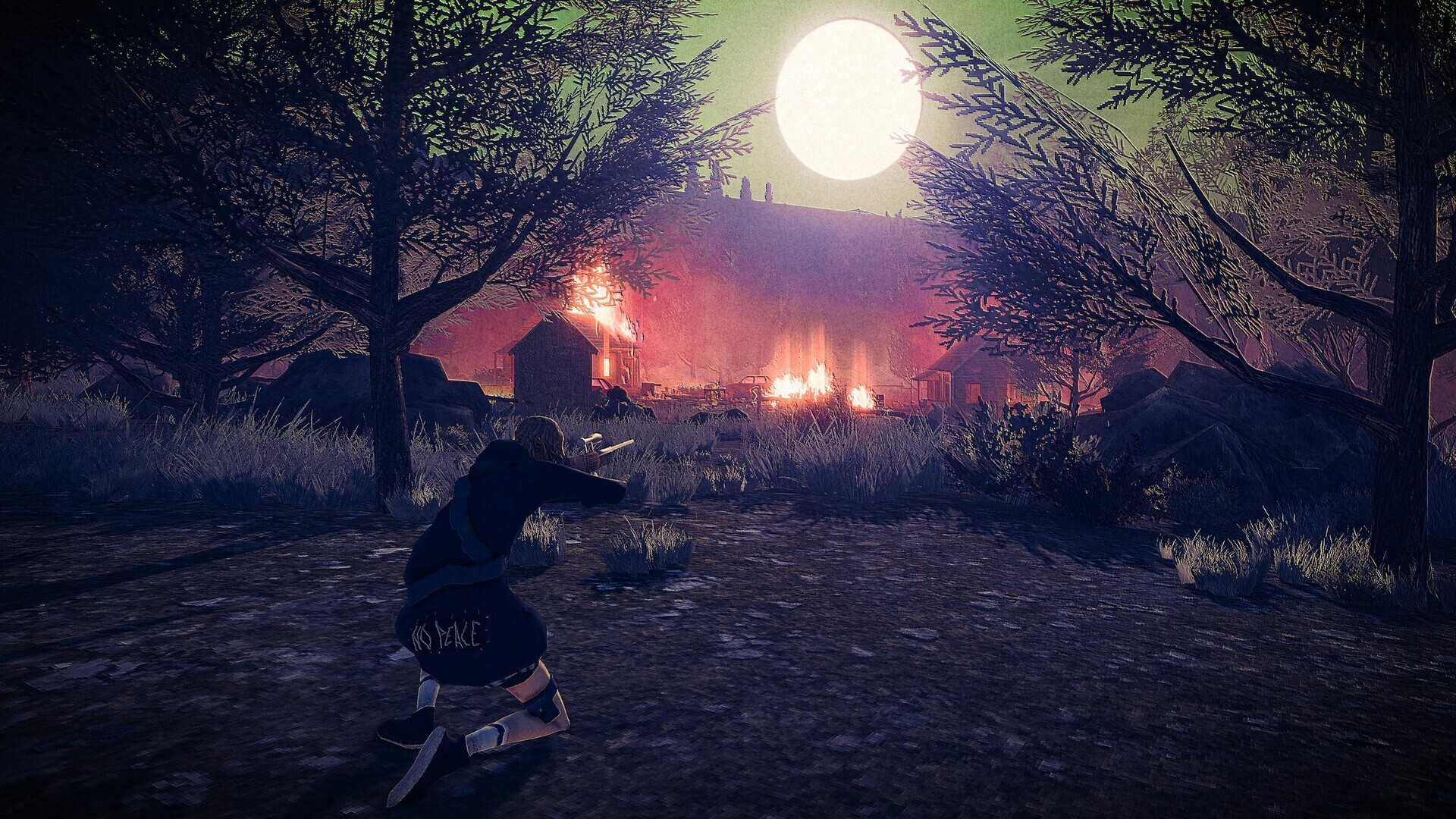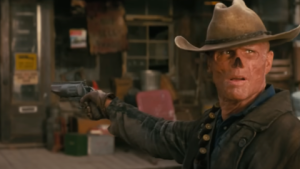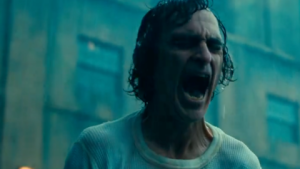
Children Of The Sun Review – One Shot
It only takes a single bullet to burn down an empire. That’s the ethos behind Children of the Sun, an excellent supernatural puzzle-shooter from solo developer René Rother and publisher Devolver Digital. Like many of the games in Devolver’s vast library, Children of the Sun is wonderfully stylish, violent, and built on a unique gameplay hook; think Sniper Elite mixed with Superhot and you’re on the right track without quite telling the whole story.
You play as a protagonist known simply as The Girl, a one-woman wrecking crew waging a vengeful war against the eponymous cult that ruined her life. As one cultist after another is turned to mincemeat behind the vindictive crosshairs of your sniper rifle, you gradually make your way up the food chain until coming face-to-scope with your true target: The Leader. While embarking on this blood-soaked killing spree, hand-drawn flashbacks reveal tidbits about the atrocities committed by this mysterious cult and The Girl’s reasons for seeking revenge.
There’s no dialogue during these cutscenes; instead, the narrative is intentionally minimalist, bombarding you with unnerving memories that are both terse and chaotic. This scattershot approach makes it difficult to glean all of the available information–perhaps deliberately so–which means you might feel lost and slightly detached from the story at times. It’s all complemented by a discordant soundscape of ambient white noise that matches the game’s striking art style–composed of deep purples and vivid yellows–and gritty, surreal tone. The game’s arresting aesthetic paints a picture of a brutal world of saturated filth, where cultists defile seedy motels, gloomy forests, and derelict apartment buildings, spreading their deceitful disease like plague-infested rats.
For as evocative as Children of the Sun’s story, visuals, and music are, it’s the innovative gameplay where it truly shines. At the beginning of each level, you’re able to move The Girl either left or right on a predetermined path. Sometimes, you can navigate around a level in a full 360-degree circle, while other times, you may only be able to move a few yards before being impeded by a fallen tree or steep riverbank. From here, you can get a lay of the land, mark enemies, and determine the best position to fire from. Once you’ve aimed down the scope and pulled the trigger, the camera snaps to the crown of the bullet as it hurtles through the air. Blood spatter and disintegrated flesh usually follow, but the catch is that this is the only shot you’ll fire for the duration of the level.
The Girl’s backstory pulls from a classic fiction trope where a young girl discovers she has latent supernatural powers once she reaches puberty. Each time a bullet is propelled through a cultist’s skull, time slows down to a crawl, and The Girl’s psychic abilities let you take control of the round and re-aim, allowing a single bullet to cleave through an entire enemy compound in one fell swoop.
Initially, you can only move the bullet in a straight line from one enemy to the next, ping-ponging between them like a murderous pinball machine, and this makes your first shot the most crucial. From that initial point of impact, you need to chart a course through every other enemy until none are left alive. This is easier said than done, of course. While some enemies remain stationary, others are walking around, circling the entire map in a car, and sitting out of view of your initial vantage point. Considering all of this, you might have to finish a level by ensuring that the penultimate kill provides a clear sightline of the final cultist, who was hidden until now. There are wrong ways to do this, but there isn’t a definitive right way, so experimentation is incentivized and rewarded.
Children of the Sun is wonderfully stylish, violent, and built on a unique gameplay hook; think Sniper Elite mixed with Superhot and you’re on the right track without quite telling the whole story
As you progress through the story and more enemy types are introduced, you’re given additional powers to counteract the likes of shielded and armored cultists and the increasingly elaborate environments they’re inhabiting. The first of these powers lets you take direct control and gently curve bullets like James McAvoy in the 2008 film Wanted. This is useful for firing over walls and bending the shot so it lurches downwards and hits the cultist on the other side, or simply tweaking the bullet’s trajectory to guarantee it lands on-target.
Another ability reveals enemy weak points, which, when destroyed in a hail of slow-motion blood, grant you the power to redirect the bullet in mid-flight. Using this, you can fire past a shield-wielding enemy and then spin the bullet around to nail them in the back of the head, entirely negating their bullet-proof protection. Other times, you might use this technique to escape a building and re-enter it elsewhere or fire into the sky to provide a better view of the area and uncover a previously elusive enemy.
Armored cultists, meanwhile, provide an altogether different challenge. The only way to penetrate their thick armor is by using a power shot–achieved by holding down the trigger for the duration of the bullet’s flight. These shots necessitate a large enough distance between targets to build up the requisite velocity needed to blow through armor, so figuring out how to remove these enemies is a unique problem. Doing so is always a thrill, though, as you get the gratification of seeing the bullet reach supersonic speeds before blasting through the cultist’s now-useless defense.
Finding a solution to each level’s grisly puzzle is immensely satisfying, especially when trial and error is abundant. Your first few attempts might revolve around tentatively exploring to find where all of the cultists are located and then figuring out the best way to carve through each one. You can sometimes use the environment to your advantage, too, shooting vehicles’ fuel caps and gas canisters to eliminate multiple enemies in one vehement explosion. You could blow up a car just to attain a better angle or snipe a pigeon flying overhead to gain a bird’s eye view of the area. I wish there were more opportunities for environmental kills besides destroying vehicles and explosive barrels, but restricting how you can interact with the world around you adds to the challenge and sense of achievement when you emerge victorious.
Gallery
At around three hours in length, Children of the Sun is a relatively brief experience. Usually, this would be a blessing in disguise for a game that doesn’t diversify from its core conceit too often, yet I still found myself desperate for more. Fortunately, replayability is rife, as the game’s scoring system encourages you to go back and replay previous levels to achieve a better rating. Headshots are scored differently from leg wounds, just as you earn more points for better timing and efficiency, while leaderboards create a sense of competition. Completing a level also reveals an excellent snapshot of the flight path of your bullet, which the game makes easy to share on social media for some extra fulfillment.
Children of the Sun’s unconventional approach to sniping is consistently thrilling and wholly satisfying. It might be full of gruesome blood spatter and cracked skulls, but it’s also the thinking person’s shooter–more of a delightfully macabre puzzle game than anything else. It’s admittedly short, and the game’s longevity will largely depend on how hard you fall for its inventive and bloody puzzles. That shouldn’t be a problem when it’s so difficult not to. And even if it’s relatively one-note, Children of the Sun plays that note with such morbid aplomb that it’s easy to recommend.
Sand Land Review – Tanks A Lot
The main character in this open-world action-RPG adaptation of the late Akira Toriyama’s Sand Land is arguably its egg-shaped tank. Developer ICLA has crafted a game with a heavy emphasis on vehicular combat and traversal, which is a fitting design choice considering Toriyama’s love and passion for anything with a motor. You only have to glance at the number of vehicles featured in the Dragon Ball series to appreciate the legendary artist’s vehicular love affair. As iconic and instantly recognizable as Toriyama’s character designs are, his unique vehicle designs are just as evocative and essential to his signature world-building. Whether it’s a car, scooter, hovercraft, or airship, Toriyama’s anomalous designs are a delight, and Sand Land’s bulbous tank is one of his best, mixing his characteristics with historical influences to create a memorable piece of machinery. ICLA’s Sand Land might lack substance beneath its oozing style, but sitting behind the cockpit of some of Toriyama’s intricately designed vehicles is a near-constant treat, even if it falters elsewhere.
The first half of the game’s story is a faithful retelling of the original 14-chapter one-shot manga released in 2000. Set in the titular wasteland, Sand Land centers on a desert world suffering from an extreme water shortage, where sci-fi, fantasy, action, and comedy intertwine. You play as the rambunctious pink-skinned demon prince, Beelzebub, a video game-obsessed fiend who’s as good as gold despite his protestations otherwise. Alongside the stern-faced Sheriff Rao and your wise old pal, Thief, you embark on a quest to uncover a rumored water source that will hopefully restore Sand Land to life. The second half of the game’s narrative covers the brand-new events featured in the recently released anime adaptation. While the first six episodes of the show rehash the familiar ground of the manga, the last seven episodes function as a sequel to the original story, with Toriyama conceptualizing a fresh tale that sees Beelzebub, Rao, and Thief embroiled in a lopsided war after venturing into the neighboring Forest Land.
Now Playing: SAND LAND – Official Story Trailer
Sand Land might not be as popular as Toriyama’s other works, such as Dragon Ball and Dr. Slump, but despite its niche nature, its recent resurgence isn’t without merit. The characters and world-building found in Sand Land are its greatest strength, and these elements are seamlessly translated into the game. The relationship between Beelzebub, Rao, and Thief is just as charming as it was on the page, while the game’s open world gives their conversations and banter space to breathe as you travel between locations. These moments excel when pulling lines straight from the manga, but pockets of incidental dialogue have a habit of repeating over and over again, which quickly becomes grating to the point where I wish I could’ve muted it completely.
Fortunately, the story itself is well told, meshing a whimsical child-like wonder with more profound explorations of prejudice, trauma, corporate greed, and the ecologism that exists in a world ravaged by humans. One of Sand Land’s main themes is a self-reflective notion not to judge a book by its cover, and Rao’s backstory focuses on the horrors of war and genocide and how they can still impact people decades after the fact. The entire core cast of characters is also well-layered, informed by their past lives while learning and growing as they unearth more information about the world and each other. The plethora of optional side quests tend to be verbose, even when their contents aren’t particularly interesting or original. Some of these tales do at least expand on Toriyama’s world-building, though, showing how regular people live and survive in the harshness of Sand Land’s vast desert landscape.
Aside from its narrative, another area where the game captures one of the manga’s core aspects is its focus on imaginative vehicles. You have access to various two- and four-wheeled machines that can be swapped on the fly as you traverse Sand Land’s open world. The iconic tank is the star of the show, sputtering fumes from its exhaust pipes as its undulating treadwheels glide over the sand; it’s surprisingly nimble despite its bulky frame, lending combat a sense of fluidity as you dodge incoming fire and pepper enemy tanks with your own booming cannon. You also have access to a secondary weapon–typically something automatic like a Gatling gun–that can be used to dispatch foot soldiers and some of the smaller beasts you’ll encounter. This creates a satisfying flow to combat as you swap between weapons while one is reloading and outmaneuver your enemies using the tank’s speed boost and inherent agility.
Customization is a significant part of the experience, allowing you to swap out either of the tank’s weapons with new and upgraded parts. There isn’t much variety in how these weapons handle, however–one cannon might fire slightly faster than another or inflict burning damage, but they still feel very much the same. Crafting new parts is also overly cumbersome, as the game doesn’t let you compare what you’re building with what you currently have equipped. Enemies scale to your level, too, so there isn’t a tangible sense of progression, even as you install new parts with higher damage output. This is disappointing and takes away from the customization’s potential. Even so, Sand Land’s tank-based action is still fun, with rewarding shooting, despite a lack of evolution. Additional cooldown-based abilities–of which you can equip one–add another element to combat. These can be focused on defense, granting you extra armor or an interception system that shoots down incoming missiles, or they can be more offensive abilities like an explosive laser or an outrigger that locks the tank in place, allowing you to rapidly fire the main cannon while stationary.
Additional vehicles include a motorbike, hovercar, dirt buggy, and jump-bot, among others. Each has its own set of weapons for use in a pinch, but these vehicles are primarily focused on traversal. The motorbike, for instance, is the fastest way to get around Sand Land’s open world, to the point where it can cross quicksand without sinking. The jump-bot, meanwhile, is a lumbering two-legged machine that lets you leap great heights to navigate the game’s various platforming sections. You might try the motorbike’s shotgun or the car’s guided-missile system in combat, but considering you can just swap to the tank at any time, the other vehicles feel superfluous once bullets start flying. The Battle Armor you unlock towards the end of the game is the only exception, mainly because it lets you uppercut enemy tanks into the air.
When you’re not piloting one of these vehicles, Sand Land takes a notable dip in quality. Being a demon prince, Beelzebub is no slouch when fighting hand-to-hand. There’s a typical mix of light and heavy attacks, plus a dodge, and you can unlock both passive and active abilities for Rao and Thief, including a personal tank Rao will pilot to help you out. Not that you’ll need much assistance. Sand Land’s melee combat is simplistic, with a string of light attacks all that’s required to defeat most enemies. Sometimes you’ll need to dodge incoming attacks–telegraphed by your opponent glowing red–and Beelzebub has a few unlockable abilities for dealing extra damage to more formidable enemies. Fighting multiple threats at once is its greatest challenge, only because there’s no way to swap between targets when locked on, resulting in an awkward back and forth. It doesn’t take long for this ponderous dance to grow stale, with the only saving grace being that melee combat isn’t too frequent.
The same can be said for Sand Land’s rudimentary stealth sections. Trial and error is the name of the game here, with an instant fail state present whenever you’re spotted. Fortunately, these clandestine moments are straightforward enough to navigate without attracting prying eyes. The main issue is that your crouched movement is slow and monotonous, offering a change of pace that wasn’t desired. Stealth also tends to occur in samey military bases, which is also an issue elsewhere. You’re forced to traverse the innards of near-identical crashed ships multiple times throughout the game, which only adds to the inane repetition of its stealth and melee combat.
The abundance of side quests are similarly bland, often tasking you with killing a certain number of enemies to either save someone or acquire crafting materials. Sometimes, you might have to search ancient ruins for a specific item or win one of the desert races, but you’re mostly just repeating the same tasks for different reasons. Most of these quests revolve around the town of Spino and your efforts to make it somewhere people would want to live. You’ll complete quests for the likes of traders and farmers that lead to them joining the town and gradually growing it throughout the game. The quests themselves might be dull, but watching the town’s progress is rewarding, especially when it comes with the convenience of putting everything you need in a single hub. It’s just a shame the process behind the town’s resurgence isn’t more engaging.
Gallery
The story behind Sand Land’s creation is funny but also sad in a way. Toriyama initially made Sand Land for his own personal enjoyment, devising a short story about an old man and his tank. However, the tank proved more challenging to draw than expected, and since Toriyama stubbornly insisted on drawing everything himself, he came to regret the idea. He persevered anyway, eventually releasing the manga for public consumption, and his pain was certainly our gain. Toriyama’s love of vehicles shines through in Sand Land and is where its most enjoyable moments reside. It’s disappointing that it flounders in other areas, particularly when it comes to stealth and melee combat, but ICLA has still managed to capture the heart and spirit of the original manga through its story, characters, and vehicular combat and traversal. Sand Land is bittersweet in many ways, but it’ss a testament to Toriyama’s talents as both an artist and storyteller that, despite its numerous flaws, it’s still worth playing.

